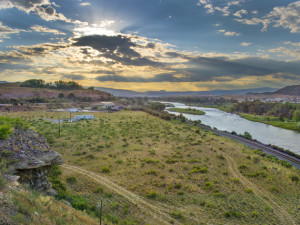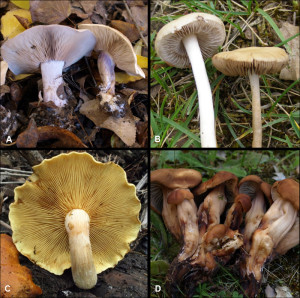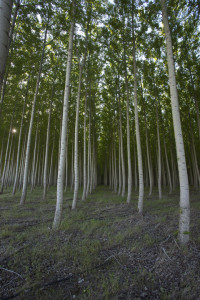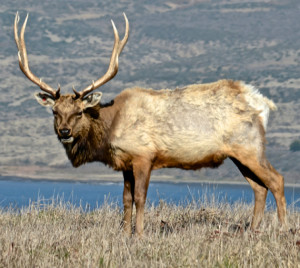The U.S. Department of Energy Joint Genome Institute (DOE JGI), a DOE Office of Science user facility, has announced that 32 new projects have been selected for the 2015 Community Science Program (CSP). From sampling Antarctic lakes to Caribbean waters, and from plant root micro-ecosystems, to the subsurface underneath the water table in forested watersheds, the CSP 2015 projects portfolio highlights diverse environments where DOE mission-relevant science can be extracted.

Near the town of Rifle, Colorado, lies the primary field site for Phase I of the Subsurface Systems Scientific Focus Area 2.0. Longtime DOE JGI collaborator Jill Banfield of UC Berkeley is profiling the diversity of microbial communities found in the subsurface from the Rifle aquifer adjacent to the Colorado River. (Roy Kaltschmidt, LBNL)
“These projects catalyze JGI’s strategic shift in emphasis from solving an organism’s genome sequence to facilitating an understanding of what this information enables organisms to do,” said Jim Bristow, DOE JGI Science Deputy who oversees the CSP. “To accomplish this, the projects selected combine DNA sequencing with large-scale experimental and computational capabilities, and in some cases include JGI’s new capability to write DNA in addition to reading it. These projects will expand research communities, and help to meet the DOE JGI imperative to translate sequence to function and ultimately into solutions for major energy and environmental problems.”
The CSP 2015 projects were selected by an external review panel from 76 full proposals received that resulted from 85 letters of intent submitted. The total allocation for the CSP 2015 portfolio is expected to exceed 60 trillion bases (terabases or Tb)—or the equivalent of 20,000 human genomes of plant, fungal and microbial genome sequences. The full list of projects may be found at http://jgi.doe.gov/our-projects/csp-plans/fy-2015-csp-plans/. The DOE JGI Community Science Program also accepts proposals for smaller-scale microbial, resequencing and DNA synthesis projects and reviews them twice a year. The CSP advances projects that harness DOE JGI’s capability in massive-scale DNA sequencing, analysis and synthesis in support of the DOE missions in alternative energy, global carbon cycling, and biogeochemistry.
Among the CSP 2015 projects selected is one from Regina Lamendella of Juniata College, who will investigate how microbial communities in Marcellus shale, the country’s largest shale gas field, respond to hydraulic fracturing and natural gas extraction. For example, as fracking uses chemicals, researchers are interested in how the microbial communities can break down environmental contaminants, and how they respond to the release of methane during oil extraction operations.
Some 1,500 miles south from those gas extraction sites, Monica Medina-Munoz of Penn State University will study the effect of thermal stress on the Caribbean coral Orbicella faveolata and the metabolic contribution of its coral host Symbiodinium. The calcium carbonate in coral reefs acts as carbon sinks, but reef health depends on microbial communities. If the photosynthetic symbionts are removed from the coral host, for example, the corals can die and calcification rates decrease. Understanding how to maintain stability in the coral-microbiome community can provide information on the coral’s contribution to the global ocean carbon cycle.
Longtime DOE JGI collaborator Jill Banfield of the University of California (UC), Berkeley is profiling the diversity of microbial communities found in the subsurface from the Rifle aquifer adjacent to the Colorado River. The subsurface is a massive, yet poorly understood, repository of organic carbon as well as greenhouse gases. Another research question, based on having the microbial populations close to both the water table and the river, is how they impact carbon, nitrogen and sulfur cycles. Her project is part of the first coordinated attempt to quantify the metabolic potential of an entire subsurface ecosystem under the aegis of the Lawrence Berkeley National Laboratory’s Subsurface Biogeochemistry Scientific Focus Area.
Banfield also successfully competed for a second CSP project to characterize the tree-root microbial interactions that occur below the soil mantle in the unsaturated zone or vadose zone, which extends into unweathered bedrock. The project’s goal is to understand how microbial communities this deep underground influence tree-based carbon fixation in forested watersheds by the Eel River in northwestern California.
Several fungal projects were selected for the 2015 CSP portfolio, including one led by Kabir Peay of Stanford University. He and his colleagues will study how fungal communities in animal feces decompose organic matter. His project has a stated end goal of developing a model system that emulates the ecosystem at Point Reyes National Seashore, where Tule elk are the largest native herbivores.

USDA-ARS researchers will develop a genome-wide collection of several thousand mutants of the model grass Brachypodium distachyon to help domesticate the grasses that are being considered as candidate bioenergy feedstocks. (Richard Sibout, INRA)
Another selected fungal project comes from Timothy James of University of Michigan, who will explore the so-called “dark matter fungi” – those not represented in culture collections. By sequencing several dozen species of unculturable zoosporic fungi from freshwater, soils and animal feces, he and his colleagues hope to develop a kingdom-wide fungal phylogenetic framework.
Christian Wurzbacher of Germany’s the Leibniz Institute of Freshwater Ecology and Inland Fisheries, IGB, will characterize fungi from the deep sea to peatlands to freshwater streams to understand the potentially novel adaptations that are necessary to thrive in their aquatic environments. The genomic information would provide information on their metabolic capabilities for breaking down cellulose, lignin and other plant cell wall components, and animal polymers such as keratin and chitin.
Many of the selected projects focus on DOE JGI Flagship Plant Genomes, with most centered on the poplar (Populus trichocarpa.) For example, longtime DOE JGI collaborator Steve DiFazio of West Virginia University is interested in poplar but will study its reproductive development with the help of a close relative, the willow (Salix purpurea). With its shorter generation time, the plant is a good model system and comparator for understanding sex determination, which can help bioenergy crop breeders by, for example, either accelerating or preventing flowering.
Another project comes from Posy Busby of the University of Washington, who will study the interactions between the poplar tree and its fungal, non-pathogenic symbionts or endophytes. As disease-causing pathogens interact with endophytes in leaves, he noted in his proposal, understanding the roles and functions of endophytes could prove useful to meeting future fuel and food requirements.
Along the lines of poplar endophytes, Carolin Frank at UC Merced will investigate the nitrogen-fixing endophytes in poplar, willow, and pine, with the aim of improving growth in grasses and agricultural crops under nutrient-poor conditions.
Rotem Sorek from the Weizmann Institute of Science in Israel takes a different approach starting from the hypothesis that poplar trees have an adaptive immunity system rooted in genome-encoded immune memory. Through deep sequencing of tissues from single poplar trees (some over a century old, others younger) his team hopes to gain insights into the tree genome’s short-term evolution and how its gene expression profiles change over time, as well as to predict how trees might respond under various climate change scenarios.
Tackling a different DOE JGI Flagship Plant Genome, Debbie Laudencia-Chingcuanco of the USDA-ARS will develop a genome-wide collection of several thousand mutants of the model grass Brachypodium distachyon to help domesticate the grasses that are being considered as candidate bioenergy feedstocks. This work is being done in collaboration with researchers at the Great Lakes Bioenergy Research Center, as the team there considers Brachypodium “critical to achieving its mission of developing productive energy crops that can be easily processed into fuels.”

Representative lifestyles in Agaricales. Images A and B depict leaf litter degrading species growing in forest (Lepista nuda) and meadow (Agrocybe pediades) habitats, respectively. Image C is of a wood decaying species (Gymnopilus junonius). Image D is of a buried wood decaying species (Gymnopus fusipes). (Jose Maria Barrasa, Universidad de Alcala)
Continuing the theme of candidate bioenergy grasses, Kankshita Swaminathan from the University of Illinois will study gene expression in polyploidy grasses Miscanthus and sugarcane, comparing them against the closely related diploid grass sorghum to understand how these plants recycle nutrients.
Baohong Zhang of East Carolina University also focused on a bioenergy grass, and his project will look at the microRNAs in switchgrass. These regulatory molecules are each just a couple dozen nucleotides in length and can downregulate (decrease the quantity of) a cellular component. With a library of these small transcripts, he and his team hope to identify the gene expression variation associated with desirable biofuel traits in switchgrass such as increased biomass and responses to drought and salinity stressors.
Nitin Baliga of the Institute of Systems Biology will use DOE JGI genome sequences to build a working model of the networks that regulate lipid accumulation in Chlamydomonas reinhardtii, still another DOE JGI Plant Flagship Genome and a model for characterizing biofuel production by algae.
Other accepted projects include:
The study of the genomes of 32 fungi of the Agaricales order, including 16 fungi to be sequenced for the first time, will be carried out by Jose Maria Barrasa of Spain’s University of Alcala. While many of the basidiomycete fungi involved in wood degradation that have been sequenced are from the Polyporales, he noted in his proposal, many of the fungi involved in breaking down leaf litter and buried wood are from the order Agaricales.
Now at the University of Connecticut, Jonathan Klassen conducted postdoctoral studies at GLBRC researcher Cameron Currie’s lab at University of Wisconsin-Madison. His project will study interactions in ant-microbial community fungus gardens in three states to learn more about how the associated bacterial metagenomes contribute to carbon and nitrogen cycling.
Hinsby Cadillo-Quiroz, at Arizona State University, will conduct a study of the microbial communities in the Amazon peatlands to understand their roles in both emitting greenhouse gases and in storing and cycling carbon. The peatlands are hotspots of soil organic carbon accumulation, and in the tropical regions, they are estimated to hold between 11 percent and 14 percent, or nearly 90 gigatons, of the global carbon stored in soils.
Barbara Campbell, Clemson University will study carbon cycling mechanisms of active bacteria and associated viruses in the freshwater to marine transition zone of the Delaware Bay. Understanding the microbes’ metabolism would help researchers understand they capabilities with regard to dealing with contaminants, and their roles in the nitrogen, sulfur and carbon cycles.
Jim Fredrickson of Pacific Northwest National Laboratory will characterize functional profiles of microbial mats in California, Washington and Yellowstone National Park to understand various functions such as how they produce hydrogen and methane, and break down cellulose.

These are hybrid poplar trees growing in Greenwood Resources plantations near Boardman, OR. These trees have the highest annual productivity of any hardwood species in North America. Several of the selected CSP 2015 projects focus on poplar, a DOE JGI Flagship Plant Genome. (DOE JGI)
Joyce Loper of USDA-ARS will carry out a comparative analysis of all Pseudomonas bacteria getting from DOE JGI the sequences of just over 100 type strains to infer a evolutionary history of the this genus — a phylogeny — to characterize the genomic diversity, and determine the distribution of genes linked to key observable traits in this non-uniform group of bacteria.
Holly Simon of Oregon Health & Science University is studying microbial populations in the Columbia River estuary, in part to learn how they enhance greenhouse gas CO2 methane and nitrous oxide production.
Michael Thon from Spain’s University of Salamanca will explore sequences of strains of the Colletotrichum species complex, which include fungal pathogens that infect many crops. One of the questions he and his team will ask is how these fungal strains have adapted to break down the range of plant cell wall compositions.
Kathleen Treseder of UC Irvine will study genes involved in sensitivity to higher temperatures in fungi from a warming experiment in an Alaskan boreal forest. The team’s plan is to fold the genomic information gained into a trait-based ecosystem model called DEMENT to predict carbon dioxide emissions under global warming.
Mary Wildermuth of UC Berkeley will study nearly a dozen genomes of powdery mildew fungi, including three that infect designated bioenergy crops. The project will identify the mechanisms by which the fungi successfully infect plants, information that could lead to the development of crops with improved resistance to fungal infection and limiting fungicide use to allow more sustainable agricultural practices.
Several researchers who have previously collaborated with the DOE JGI have new projects:
Ludmila Chistoserdova from the University of Washington had a pioneering collaboration with the DOE JGI to study microbial communities in Lake Washington. In her new project, she and her team will look at the microbes in the Lake Washington sediment to understand their role in metabolizing the potent greenhouse gas methane.
Rick Cavicchioli of Australia’s University of New South Wales will track how microbial communities change throughout a complete annual cycle in three millennia-old Antarctic lakes and a near-shore marine site. By establishing what the microbes do in different seasons, he noted in his proposal, he and his colleagues hope to learn which microbial processes change and about the factors that control the evolution and speciation of marine-derived communities in cold environments.
With samples collected from surface waters down to the deep ocean, Steve Hallam from Canada’s University of British Columbia will explore metabolic pathways and compounds involved in marine carbon cycling processes to understand how carbon is regulated in the oceans.
The project of Hans-Peter Klenk, of DSMZ in Germany, will generate sequences of 1,000 strains of Actinobacteria, which represent the third most populated bacterial phylum and look for genes that encode cellulose-degrading enzymes or enzymes involved in synthesizing novel, natural products.

A project from Stanford University’s Kabir Peay of focuses on how fungal communities in animal feces decompose organic matter. His project has a stated end goal of developing a model system that emulates the ecosystem at Point Reyes National Seashore, where Tule elk are the largest native herbivores. (David McSpadden via Flickr, CC BY-2.0)
Han Wosten of the Netherlands’ Utrecht University will carry out a functional genomics approach to wood degradation by looking at Agaricomycetes, in particular the model white rot fungus Schizophyllum commune and the more potent wood-degrading white rots Phanaerochaete chrysosporium and Pleurotus ostreatus that the DOE JGI has previously sequenced.
Wen-Tso Liu of the University of Illinois and his colleagues want to understand the microbial ecology in anaerobic digesters, key components of the wastewater treatment process. They will study microbial communities in anaerobic digesters from the United States, East Asia and Europe to understand the composition and function of the microbes as they are harnessed for this low-cost municipal wastewater strategy efficiently removes waster and produces methane as a sustainable energy source.
Another project that involves wastewater, albeit indirectly, comes from Erica Young of the University of Wisconsin. She has been studying algae grown in wastewater to track how they use nitrogen and phosphorus, and how cellulose and lipids are produced. Her CSP project will characterize the relationship between the algae and the bacteria that help stabilize these algal communities, particularly the diversity of the bacterial community and the pathways and interactions involved in nutrient uptake and carbon sequestration.
Previous CSP projects and other DOE JGI collaborations are highlighted in some of the DOE JGI Annual User Meeting talks that can be seen at http://usermeeting.jgi.doe.gov/past-speakers/. The 10th Annual Genomics of Energy and Environment Meeting will be held March 24-26, 2015 in Walnut Creek, Calif. A preliminary speakers list is posted at http://usermeeting.jgi.doe.gov/ and registration will be opened in the first week of November.